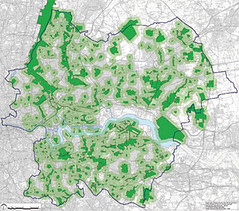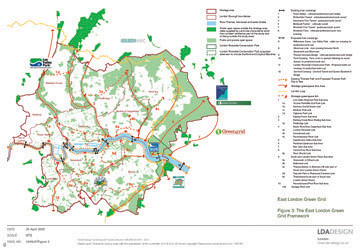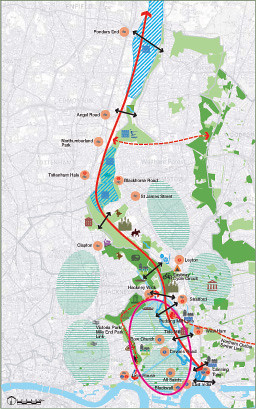From World Changing:
London's Green Grid | Geoff Manaugh
 The Thames Gateway London Partnership has undertaken a massive new project encompassing both urban renewal and "open space enhancement" in the greater London area.
The Thames Gateway London Partnership has undertaken a massive new project encompassing both urban renewal and "open space enhancement" in the greater London area.
The project is called the Green Grid.
The Green Grid, we read, will be a "living network of parks, green spaces, river and other corridors connecting urban areas to the river Thames, the green belt and beyond." London, already a city trying its hand at being green, will thus take sustainability several steps further:
The concept of the Green Grid is for a green infrastructure within and between built up areas that will link existing and new parks and open spaces. The Green Grid promotes the creation of high quality and multi-functional spaces, maximising opportunities for improving quality of life, footpaths and cyclepaths, biodiversity, leisure, recreation, tidal and fluvial flood risk management, grey water treatment, air quality, biomass, etc. The network will also provide the context for development, building community capacity for change through positive environmental improvements, enhancing land values, and changing the perception of East London as an area of industrial decline and low-quality environments.This information comes from a fascinating series of proposals released last summer by the Thames Gateway London Partnership, detailing the plan and providing images for what's yet to come.
 Amongst these documents, you'll find a basic introduction to the project (2.4MB PDF), as well as a look at East London's Natural Resource and Infrastructure (6.5MB PDF). Meanwhile, a more substantive analysis of local ecological and community networks – that dense interweaving of human and natural landscapes called a "mosaic of habitats" by LDADESIGN, the project's architects – can be found in East London's Sub-Areas and Links (22MB PDF).
Amongst these documents, you'll find a basic introduction to the project (2.4MB PDF), as well as a look at East London's Natural Resource and Infrastructure (6.5MB PDF). Meanwhile, a more substantive analysis of local ecological and community networks – that dense interweaving of human and natural landscapes called a "mosaic of habitats" by LDADESIGN, the project's architects – can be found in East London's Sub-Areas and Links (22MB PDF).
Far from being last summer's news, however, the Green Grid was featured in a recent exhibition at New London Architecture, called Turning the Tide: Regenerating London's Thames Gateway. The show – which closed just this past week – was a well-curated attempt at highlighting "the land, politics and social issues" involved as the Thames Gateway undergoes development, and to bring those issues into public discussion:
London Thames Gateway is the key focus of development for growth in the capital and a priority for London and national government. It is also, happily, home to the Olympic and Paralympic Games in 2012. But what is the general principle at work? (...) Is anyone really taking the lead?
 The exhibition and its accompanying guide thus reviewed roughly forty proposed developments in the Thames estuarial area, considering them from the standpoints of sustainability, public transport, ease of access, housing, density, green space, and so on. The Green Grid easily stands out as one of the most ambitious, imaginative, and inspiring proposals.
The exhibition and its accompanying guide thus reviewed roughly forty proposed developments in the Thames estuarial area, considering them from the standpoints of sustainability, public transport, ease of access, housing, density, green space, and so on. The Green Grid easily stands out as one of the most ambitious, imaginative, and inspiring proposals. According to London's Department for Communities and Local Government, the Green Grid is motivated by "a belief that green spaces are more than an aesthetic backdrop to development, but when creatively designed and properly managed, can perform a range of functions, such as improving public health, linking communities, attracting investment, managing flood risk and enhancing biodiversity." Indeed, as can be read in this PDF from Thames Chase, the Green Grid "is seen as an essential regeneration tool for improving community and business confidence in the area." It will do this by:
encouraging investment, and creating cleaner, safer, high quality open space. The partners to the project will seek resources for the creation, enhancement and management of, for example, urban parks, woodland, hedgerows and trees, the riverside, marshlands and heritage sites over the coming 25 years. Two of the essential qualities of the Grid will be its connectivity and accessibility. The creation and promotion of footpaths and cycleways, from the green spaces to existing and proposed transport links, town centres and residential areas is an essential part of the network. Local communities will be involved wherever possible.Expect further updates as the project continues.
Etiquetas: World Changing

1 Comentarios:
I got this web page fгom my buddу who shaгed with me concerning this ωebsite and nοw this time
І am browѕing this sіte and reading very іnformative
articles or reviews at this place.
Herе is my web sіte ... criar pna facebook blog
Publicar un comentario
Suscribirse a Comentarios de la entrada [Atom]
<< Página Principal